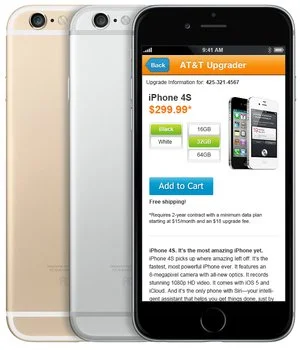CASE STUDIES Customer Driven Product Design
AT&T Mobile App Buy Flow Reimagined Improves Revenues
Greater than 65% of AT&T’s Small Business customers attempt to use their mobile device to upgrade their products and service through AT&T’s web application. The use of responsive design has failed to support the needs of the customers due to stubborn legacy systems, complex user flows, and poor execution of responsive UI design. The mobile app needs to support the needs of a diverse user group that purchases single products to bulk purchases and multiple service upgrades simultaneously.
The Challenge
Current digital experience is responsive from a poorly performing web application.
The mobile device drop-off rate is >80%. Customer surveys indicate the users are confused and frustrated with the buy flow.
1 month to complete a new mobile device experience and hand off to the development team.
The Approach
Due to a shortened timeline it is imperative to transform the mindset of the product and development teams to fail fast, iterate, and pivot.
Create a collaborative culture among designers, researchers, product managers, and development.
Develop various personas of customers buying singe products to bulk buys.
Define customer goals and AT&T’s business objectives in context of a mobile experience.
Constant communication with development teams during prototyping phase to enable a collaborative discussion around technical requirements.
The Solution
The design must support a scalable platform for fluid development over time.
Design a mobile experience independent of the web application.
Create a thoughtful and scalable experience supporting transactions ranging from single product purchases to bulk buys.
Combining product and service setup pages to minimize user flows thus reducing user confusion.
Team Make Up
Marty’s Role: Senior UX Strategist leading a team of 4 UX design professionals with a diverse set of design skills; research, information architecture, concepting & design, prototyping and UI writing.
1 Information Architects
1 Interaction Designer/Prototyper
1 UI Content Strategist
1 UX Researcher
Data Synthesis and Low Fidelity Designs
Collaboration Sessions with Co-Creators
Creating a problem statement from quantitative and qualitative data allows the product development team and stakeholders to identify a uniformed approach to solving the users needs. Through a synthesis exercise the team was able to identify user tasks and developed a theme to create hypotheses to test.
AT&T - Apple iPhone Buy Flow
These wireframes are used to demonstrate the buy flow’s functionality and interaction design. Stakeholders agreed that minimal steps to accomplish the transaction is priority. Analysis from usability tests complimented the stakeholders decision.
A Reimagined Buy Flow Cut In Half
The updated product selection and buy flow went from eight screens with multiple interactions to four screens driving intuitive interactions. Customers select and purchase the product and service in under 5 minutes.
Collaboration Throughout Ideation
The Results
>30% increase in completed buy flow transaction.
<45% drop-off rate from >90% from the shop and learn experience.
An increase in sales during iconic product releases due to the implementation of 2-week Sprint cycles allowing for dynamic marketing strategies of new product bundles.






